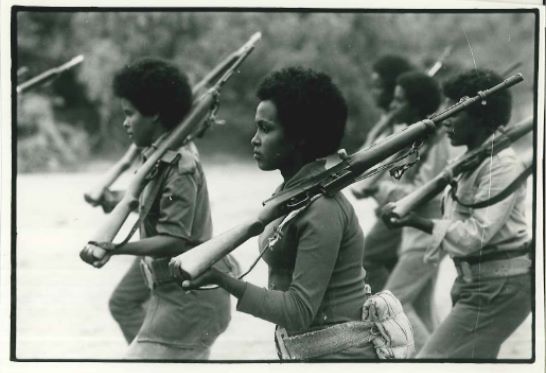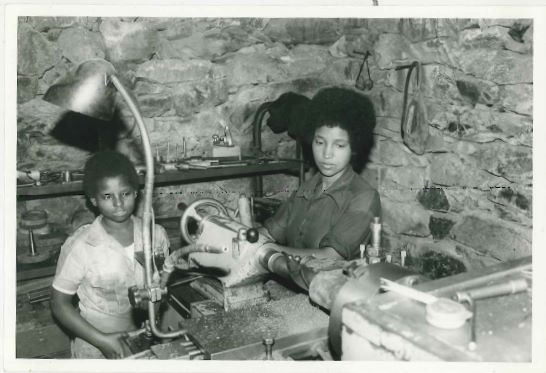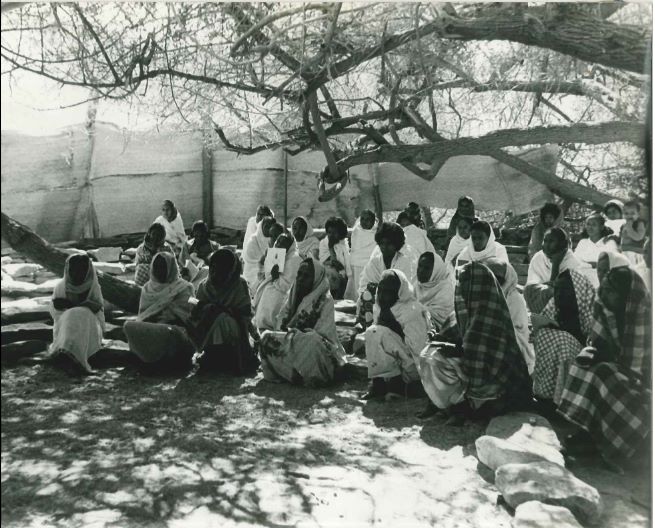Network of Eritrean women held on 6/12/14 in London. A move to empower the Eritrean women
 Women were fighting and emerging from centuries of being held down. It has been a difficult battle which is still not complete.
Women were fighting and emerging from centuries of being held down. It has been a difficult battle which is still not complete.
During the long armed struggle one of the objectives of Eritrean revolutionaries was to combat the oppression of women in Eritrea. Eritrea is a patriarchal society were the women are relegated to the kitchen and rear children. Women in the struggle were fighting a double oppression against the repressive Ethiopian rule and male domination. The Eritrean People’s Liberation Front (EPLF) slogan was “Emancipation of women through participation.” (ማዕርነት ብስራሕ ተኻፋልነት) .
Women participated in all areas of activities hitherto dominated by men. They served as doctors, nurses, bare foot doctors following the trails of nomads and go to villages to deliver first aid and give advice on health, pregnancy and other health matters. They worked in garages, as machine tool operators (see photo), as teachers scattered in villages to combat illiteracy, in the media in factories such as the pharmaceutical factory producing up to 300 types of drugs unprecedented in any armed struggle. EPLF was self-sufficient in sandals the fighters and peasants wear produced in the shoe factory. Above all they represented 30% of the combatants. Many foreign journalists, politicians, human rights activist wrote books and articles and made films about them. One of the best film is by a German film maker Gordon Troller – covered their life and work in the field. . Baroness Glyness Kinnock together with James Firebrace, head of Africa desk of War on Want wrote a book titled “Images of War and Peace “. Amrit Wilson – book was titled “The Challenge Road – Women and Revolution in Eritrea”. Amrit Wilson was the partner of Abdurrahman Babu- ardent supporter and promoter of the case of Eritrea. After he returned from his visit to the field in mid-eighties he wrote an article in African Magazine in London titled “The present situation in Eritrea is a remote future of other African Countries.” He is lucky he died before he witnessed the terrible reversal. He would have died a broken man seeing his dreams of Africa and the dreams of the people of Eritrea who sacrificed so much crushed. When Ethiopia and Eritrea forged close relationship at the end of many years of fighting the international community hailed and embraced it so much so President Clinton used to label President Isaias, PM Meles Zenawi and Nelson Mandela as Africa’s new leaders who ushered in the renaissance of Africa. But all these and other forms of goodwill and the ambassadorial work of the mass associations was squandered by PFDJ.
Baroness Kinnock has written an article about women in Eritrea on March 8, celebrating March 8, International women’s day. She appealed the release of the women and all prisoners of conscience. She mentioned some name especially Aster Fitzehazion whom she knew personally. She also wrote a personal letter to president Isaias protesting the imprisonment of Erimias Debesay (Papayo) whom she worked closely with. He obviously gave her a deaf ear.
Eritrean women showed their commitment and courage by working in the occupied area. They were smuggling commodity goods such as sugar, starch medicines and many were caught and ended up in prison or killed. The book by Abeba Tesfagiorgis “the Odyssey of Eritrea Mother” has covered interview with some of the prisoners in which she was one. After independence the ex-prisoners applied to form an association but rejected and their risky work and substantial material support to EPLF was never recognised.
PFDJ has robbed the amazing history of Eritrean women in particular and the people in general. The entire leadership who would have told most of the history of EPLF, the victories the failures, the hardships and the dark side are all incarcerated.
The Network of Eritrean Women UK vowed to empower women first and foremost.
What is unique about the network of women in London is that they seem to be aware of the shortages of the past revolutionary struggle. The women during the revolution had managed to participate in all activities of life but they never have any power of decision making. After independence they were not represented in the Government, they have no say about the indefinite national service which is affecting their life and their children’s life directly and is bringing about the disintegration of the fabric of Eritrean society.
I had an extensive discussion with Dr Sara Ogbai one of the organisers, together with Khedijah Mohamed Nur. She said “to empower the women is our priority. We cannot afford to be the tool of the ruling elite. However, there are barriers to empower the women. Lack of confidence – low qualification- language problem and face fierce competition to get employment. Therefore skills training and hard work is essential.”
Addressing these problems is a very good beginning they can organise training in community centres which is a form of empowering the women by improving their skills. All these activities also represents a revolution in consciousness. At the same time they will be in a position to organise entertainment, plays, and jokes and develop strong comraderies as they develop their culture of justice and freedom.
Overall contribution of the women in the Diaspora is very significant. Dr Alganesh, Khedijah, Feruz, Selam, Elsa Chyrum, Dr Harnet Bocrezion , Lul Seyum – Feven Hadera and Feven Solomon – Amal Ali, Asia Abyssinia Jobe, Dr Sara. .Meron’s achievement is profoundly remarkable. Her documentary film “The Sound of Torture” is remarkable. All these women are bigger than life and will go to the annals of history as such.
It goes without saying that it is these women who are providing moral compass to the fragmented Eritreans in Diaspora. Their strong side is that they are action oriented generally absent in the diaspora’s political jungle where there are more than 30 political organisations and more than 60 civil societies.
Yes, the Eritrean women are in the process of creating the future of Eritrean women and the society in general but I have a serious concern that they don’t seem to cooperate to achieve more and maintain high profile. They have to overcome these shortages if they hope to play a pivoted role in mobilizing the women to effectivgely and organisationally participate in the activities that defines the destiny of Eritrea. No doubt the pendulum will keep swinging in the direction it needs to swing in order to find is equilibrium, and I do believe that the Eritrean men as well can be part of the change for democracy and for equality between men and women.
See photos: 1.combatants 2. Machine operator 3. Literacy campaign by women to women.



The end:
Next: The battle of the extraction of minerals in Eritrea: based on
- The Early Day Motion (EDM) number 544. Submitted in the House of Commons. United Kingdom, “That this House (means the Parliament) condemns the human rights abuse perpetrated by the Government of Eritrea……… and the broader context of the activities of which the motion is just a part.
- Public talk- may or may not be in reaction to EDM - a mining expert Dr Tim Williams – talks on the mining situation in Eritrea. Date 12 December 2014. The title is “Eritrea, through the lens of Business Ethics and Sustainability.
- A lawsuit filed against the Canadian Company Nevsun which owns 60% of the Bisha gold, copper and Zinc mine in Western Eritrea by three Eritrean refugees who allege they were forced to work on the construction of mines against their will in abhorrent conditions. Since 2011, the mine has generated more approximately 1.6 billion US dollars in revenue, $250 million of which went to the Eritrean Government.
What is the reactions of the Diaspora in all these? To watch the battle as it doesn’t concern them, or give moral, financial and political support to the incredible initiatives by 3 individuals in the case of class action in Canada and few business men and women in the work of EDM and its broader context..


![[AIM] Asmarino Independent Media](/images/logo/ailogo.png)